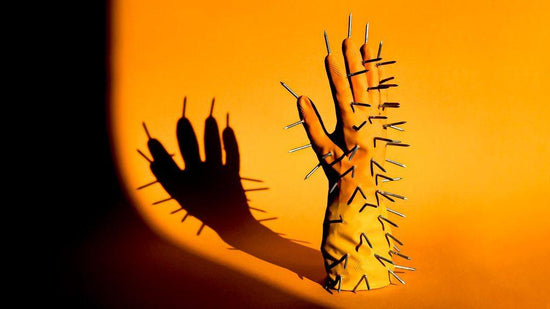
Why I hide my chronic pain from people
"The main reason why I hide my chronic pain from people is that I don't want to give them a reason to exclude me." | Photo Credit: ©DisobeyArt / Adobe Stock
Why I hide my chronic pain from people
"The main reason why I hide my pain from people is that I don’t want to give them a reason to exclude me."
There was a time when I used to paint abstract watercolors. I found it very relaxing, and it helped me forget the chronic pain my dwarfism causes. Because dwarfism not only causes emotional pain — it can also cause physical pain.
Every once in a while, when painting, I noticed something familiar as I moved my brush: a shoulder here, a rib there. And so, I would add some simple lines to enhance what I saw.
The process always mattered more to me than the end product: losing myself in the colors that appealed to me that day, randomly spreading them around, adding water here and there, tilting the page, and letting my eye decide where the paint should flow.
For over ten years, almost no one except the closest of friends, and my wife, has ever seen these paintings, mostly due to my shyness. Also, I’m not a trained artist in any way, shape, or form.
My doodles and paintings are simply an expression of what is inside me and not something I consider public consumption. With this painting that I call “Pain in My Neck,” I make an exception because I think it can serve as a reminder to us all to look beyond the surface, especially when we look at each other.

There was a time in my life I used to get a pinched nerve in my neck, about two or three times per year. Each time this happened, my neck felt like it was on fire for several days, and I could hardly move it. Nothing but sleep would ease my suffering. And in the daytime, I hid that pain carefully from the world, hardly ever letting it show on my face.
I wish I were clever and skilled enough as an artist to say that this painting was intentional. But like all my abstract artwork, it is just one of the meditative things I do to shift my consciousness away from my body and into a happier headspace, even if some of the results appear to be of a dark or sad nature. I let my mind and hands wander, and then later, I reflect on the results to see what my subconscious might be trying to say.
Pain is a signal
Pain is somewhat like depression: many people experience it to a certain extent, mostly temporarily, but few understand the full impact when these things reach acute levels. Chronic and persistent pain, like depression, has a draining effect that bleeds the color and joy from our lives. Sometimes I feel my chronic pain is killing me.
As a disabled person, one of the main reasons why I hide my chronic pain is because there are already enough visual reminders to the outside world that I’m not like most other people. I do not want to give society another reason to count me out, to exclude me, to say to themselves, “Oh, Frank can’t do this certain activity; he has too much pain.” So, instead of revealing my misery, I bury my pain and push forward, pretending that all is well. I’m not saying it’s the right thing to do; it is just how I handle things in my own life.
But the main reason why I hide my pain from people is that I refuse to let it stop me from enjoying a full life. After all, pain is just a signal from my nerve endings that tells my brain something might be wrong in some part of my body. Having experienced pain for virtually my whole life, mostly due to osteoarthritis and seven orthopedic surgeries, I know nothing can be done except relax whenever possible and take non-prescription painkillers when necessary.
Having shared this painting and my thoughts about it with you, I ask that the next time you look at another person, remember that no matter their calm exterior, you actually have no clue the pain they may be feeling on the inside. This holds for emotional and not just physical pain. As you interact with people, remember to treat each other with gentleness and kindness and be the cooling, soothing rain that can put out those painful fires wherever you go, instead of assuming people are okay.
This article, “Why I hide my pain from people,” is an adapted version of “A Pain the Neck” by Frank Verpaelst, used under CC BY 4.0. “Why I hide my pain from people” is licensed under CC BY 4.0 by Brendan McDonald.










